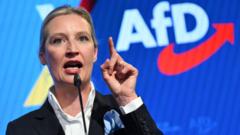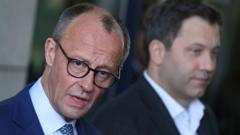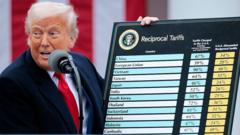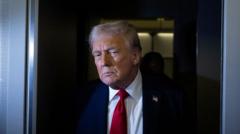The 2025 German elections produced significant changes in voter behavior and party dynamics, particularly in the context of increasing support for the Alternative for Germany (AfD), which has secured its position as a central player. Here are five crucial observations from the election results:
**Shifting Political Landscape in Germany: Key Insights from the 2025 Election**

**Shifting Political Landscape in Germany: Key Insights from the 2025 Election**
The recent German elections reveal dramatic shifts in voter support and political allegiances across the nation, indicating a pivotal moment in the country's democratic landscape.
**1. AfD's Growing Influence Across the Nation**
The AfD has made remarkable gains, doubling its support from four years ago to 20.8%. Once predominantly popular in the eastern states, it is now extending its reach into the western regions, signaling a shift in traditional party loyalty. While mainstream parties have historically rejected collaboration with the AfD, labeling it as extremist, its growing acceptance among voters illustrates changing perceptions, notably in cities like Duisburg.
**2. Record Voter Turnout**
Germany experienced its highest voter turnout in four decades, with 82.5% participation. This notable increase from 76.6% four years prior demonstrates heightened political engagement among the electorate amidst pressing national issues and an invigorating campaign season featuring numerous televised debates.
**3. Departure of Established Political Figures**
The collapse of outgoing Chancellor Olaf Scholz's three-party coalition has led to the resignation of key party leaders. Christian Lindner of the FDP announced his exit after a long political career, while Scholz plans to step back from active politics after the formation of a new government post-election.
**4. Resurgence of the Left Party**
The Left party, previously forecasted to struggle, revitalized its status through effective social media outreach, significantly influencing younger voters. Co-chair Heidi Reichinnek's viral presence on platforms like TikTok helped secure nearly 9% of votes, showcasing the increasing importance of digital communication in political mobilization.
**5. Diverging Voting Trends Among Generations**
Interestingly, the younger demographic exhibited a tendency towards both left-leaning and right-leaning parties, with the AfD capturing 21% of the 18-24 vote. Meanwhile, traditional parties like the Christian Democrats maintained stronger support among older voters, indicating a generational divide in political preferences.
These findings from the recent election underscore a profound transformation in German politics, which may have lasting implications for national governance and party dynamics in the years to come. As Germany navigates this change, the outcome reflects not only current sentiments but also sets the stage for future debates on immigration, democracy, and party ideology.
The AfD has made remarkable gains, doubling its support from four years ago to 20.8%. Once predominantly popular in the eastern states, it is now extending its reach into the western regions, signaling a shift in traditional party loyalty. While mainstream parties have historically rejected collaboration with the AfD, labeling it as extremist, its growing acceptance among voters illustrates changing perceptions, notably in cities like Duisburg.
**2. Record Voter Turnout**
Germany experienced its highest voter turnout in four decades, with 82.5% participation. This notable increase from 76.6% four years prior demonstrates heightened political engagement among the electorate amidst pressing national issues and an invigorating campaign season featuring numerous televised debates.
**3. Departure of Established Political Figures**
The collapse of outgoing Chancellor Olaf Scholz's three-party coalition has led to the resignation of key party leaders. Christian Lindner of the FDP announced his exit after a long political career, while Scholz plans to step back from active politics after the formation of a new government post-election.
**4. Resurgence of the Left Party**
The Left party, previously forecasted to struggle, revitalized its status through effective social media outreach, significantly influencing younger voters. Co-chair Heidi Reichinnek's viral presence on platforms like TikTok helped secure nearly 9% of votes, showcasing the increasing importance of digital communication in political mobilization.
**5. Diverging Voting Trends Among Generations**
Interestingly, the younger demographic exhibited a tendency towards both left-leaning and right-leaning parties, with the AfD capturing 21% of the 18-24 vote. Meanwhile, traditional parties like the Christian Democrats maintained stronger support among older voters, indicating a generational divide in political preferences.
These findings from the recent election underscore a profound transformation in German politics, which may have lasting implications for national governance and party dynamics in the years to come. As Germany navigates this change, the outcome reflects not only current sentiments but also sets the stage for future debates on immigration, democracy, and party ideology.





















